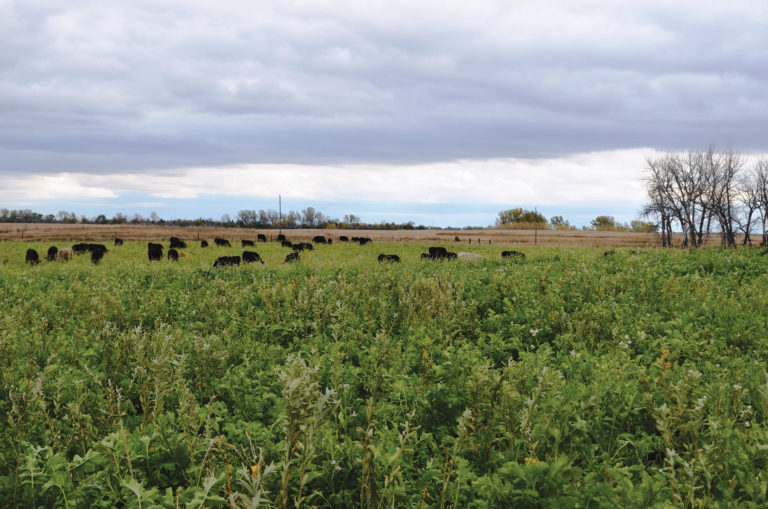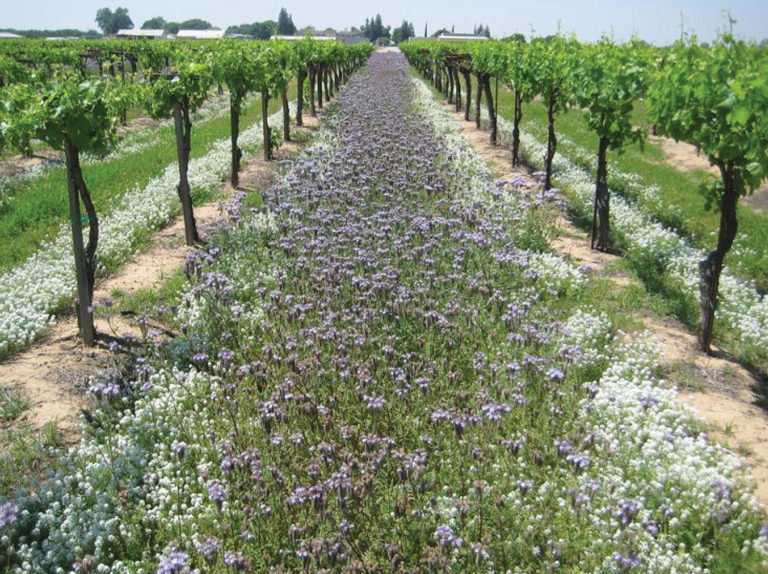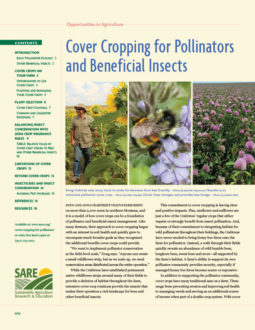Doug and Anna Crabtree's Vilicus farm rests on more than 2,000 acres in northern Montana, and it is a model of how cover crops can be a foundation of pollinator and beneficial insect management. Like many farmers, their approach to cover cropping began with an interest in soil health and quickly grew to encompass much broader goals as they recognized the additional benefits cover crops could provide.

“We want to implement pollinator conservation at the field-level scale,” Doug says. “Anyone can create a small wildflower strip, but as we scale up, we need conservation areas distributed across the entire operation.”
While the Crabtrees have established permanent native wildflower strips around many of their fields to provide a skeleton of habitat throughout the farm, extensive cover crop rotations provide the muscle that makes their operation a rich landscape for bees and other beneficial insects.
This commitment to cover cropping is having clear and positive impacts. Flax, sunflower and safflower are just a few of the Crabtrees’ regular crops that either require or strongly benefit from insect pollination. And, because of their commitment to integrating habitat for wild pollinators throughout their holdings, the Crabtrees have never needed to bring honey bee hives onto the farm for pollination. Instead, a walk through their fields quickly reveals an abundance of wild bumble bees, longhorn bees, sweat bees and more—all supported by the farm’s habitat. A farm’s ability to support its own pollinator community provides security, especially if managed honey bee hives become scarce or expensive.
In addition to supporting the pollinator community, cover crops have many traditional uses on a farm. These range from preventing erosion and improving soil health to managing weeds and serving as an additional source of income when part of a double-crop system. With cover crops planted on more than 10 million acres annually, many farmers already appreciate the role diverse agroecosystems play in improving crop productivity. In the 2012 and 2013 growing seasons, corn yields increased 9 percent and 3.1 percent, respectively, when following a cover crop, and soybean yields increased 10 percent and 4.3 percent, according to a two-year survey of farmers conducted by North Central Region SARE and the Conservation Technology Information Center (CTIC). While the CTIC-SARE survey revealed that 38 percent of cover crop users already choose plants in order to support pollinators [1], cover crops reap many additional benefits.
Flowering cover crops can fulfill their original purpose as a conservation practice while at the same time providing valuable forage for wild bees and beneficial insects. This added benefit can be significantly enhanced with some fine-tuning of management practices and thoughtful plant selection.
This bulletin will help you use cover crops to encourage populations of pollinators and beneficial insects on your farm while you address your other resource concerns. It begins with a broad overview of pollinator and beneficial insect ecology, then describes cover crop selection and management, how to make cover crops work on your farm, and helpful and proven crop rotations. It will also touch on the limitations of cover crops and pesticide harm reduction, among other topics.
Basic Pollinator Ecology
In addition to the domesticated European honey bee, roughly 4,000 species of wild bees can be found in the United States. Among these, honey bees and bumble bees are social animals, living in complex family units with a single queen, female workers (the daughters of the queen) and a few male bees called drones. In contrast, most wild bees (except for bumble bees) are solitary animals, with each female locating and provisioning her own nest.
Honey bees and wild bees alike are considered important agricultural pollinators, and both groups of bees share many of the same habitat requirements necessary to thrive. Both require reliable and abundant pollen and nectar resources throughout the growing season. In the case of honey bees, nectar demands can be significant, requiring large-scale flowering habitats to produce surplus honey.
In addition to the availability of food, honey bees and wild bees require protection from pesticides. While large doses of pesticides may be directly lethal to bees, smaller doses can result in sublethal impacts, such as reduced reproduction or foraging. Interestingly, research suggests that diverse pollen and nectar resources may help improve the overall health of bees and increase their chances of detoxifying low doses of some pesticides.
Along with food availability and pesticide protection, wild bees have a third habitat requirement: undisturbed areas for nesting. In the case of many wild bee species, the preferred nesting areas are undisturbed soils. These soil-nesting wild bees excavate underground tunnels and provision them with pollen clumps, onto which they lay their eggs. Other wild bee species nest in the hollow stems of plants, including the stems of some trees, shrubs, large grasses and even large wildflowers. A few species, including bumble bees, typically nest in the abandoned underground burrows of small rodents, or in other similar cavities.
Other Beneficial Insects
The natural enemies of crop pests that sometimes inhabit farms include a diverse range of predatory beetles, aphid-eating flower flies, lacewings, small solitary parasitic wasps and many others.
In addition to preying upon crop pests, most of these predatory and parasitoid insects either need or benefit from alternative food sources during at least one stage of their life. In some cases that alternative food source is nectar or pollen. Consequently, like pollinators, many of these natural pest enemies also benefit from flowering cover crops.
A SARE-funded group of University of California researchers demonstrated that mixed species of flowering cover crops in vineyards increased beneficial insect populations [2]. The increase in beneficial insects, brought about by a mix of annual buckwheat, lacy phacelia, sweet alyssum, bishops weed and wild carrot, resulted in fewer pests, such as the vine mealy bug.
In other cases, cover crops can support beneficial insect populations even when they do not flower. Some predators and parasitoids do not feed on nectar and pollen, but rather need a continuous supply of prey insects to maintain their local populations at an effective level. So when cash crops are absent, non-flowering cover crops can support pests to the extent that they become a stable food source for beneficial insects. For example, ground beetles, which are generalist predators of slugs, caterpillars and grasshopper eggs, can be sustained by leaving some areas unmowed or by creating a “beetle bank” of perennial grasses outside crop fields. Beetles can overwinter in this augmented habitat and their prey can breed in it. Thus, these grassy refuges can keep the beetle population high by providing both habitat and a food source outside the cropping period.
Similarly, even if prey insects found in cover crops are not pests of your cash crops, they can still be an important food resource for predator and parasitoid insects that will switch their prey preference once cash crop pests become available.
Finally, like pollinators, predatory beneficial insects need protection from insecticide applications and vegetative structures for egg-laying or overwintering. Well-managed cover crop systems can help meet these habitat requirements.
PERENNIAL COVER FOR ORCHARDS AND VINEYARDS

Fast-growing annual cover crop species such as rye and crimson clover are the most common choice for rotation with annual field crops. However, in perennial farm systems such as orchards and vineyards, longer-term ground cover may be desired. In these settings, the ground cover may have multiple demands placed upon it, including erosion control, nutrient management, and pest and disease suppression. As long as these perennial ground covers are combined with a thoughtful and careful approach to pesticide use, pollinator conservation can be very compatible with other goals.
For example, perennial turf grass in orchards can be enhanced for pollinators simply by tolerating non-invasive weeds such as violets or dandelions. To go a step further and actively increase pollen and nectar resources, such perennial turf grass systems can be over-seeded with various low-growing perennial clovers. Where these approaches are used, it is critical that insecticides not be over-sprayed and allowed to drift down onto flowering plants in the ground cover. Some farmers with these types of ground covers simply mow them to remove flowers before spraying. Although a mowed ground cover without flowers may significantly reduce the landscape value for pollinators, it is preferable to killing bees that might otherwise move on to areas where no spraying is taking place.
In perennial crop systems where no insecticides are used, ground cover options may be even more diverse and expansive. In such cases it may be possible to establish an entirely native grassland, meadow or diverse prairie as an understory. These systems typically provide maximum benefits to pollinators and other beneficial insects, and they are well adapted to the local climate and do not require routine mowing or irrigation. With appropriate plant selection and proper management, flowering cover crops can support the habitat requirements of bees through pollen and nectar resources to maximize their health and reproductive potential, an abundance of nectar to produce surplus honey, a refuge from insecticides, and sometimes enhanced nesting opportunities for wild bee species.
